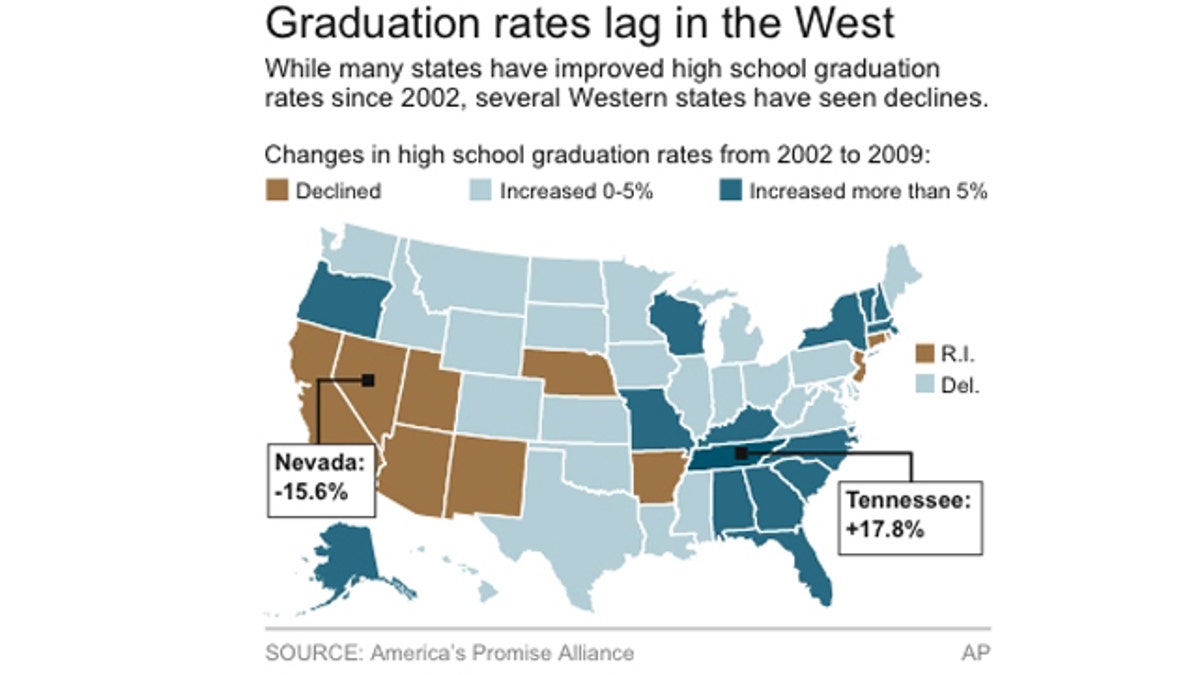
HOLD FOR RELEASE AT 12:01 A.M. EDT; Map shows change in high school graduation rates since
Despite improvements in national high school graduation rates, more than one million high school students in the United States do not graduate with their class each year --including one in three Latinos-- says a new report by Grad Nation -- a coalition of cross-sector non-profits lead by America's Promise Alliance.
Although the national graduation rate increased from 72.6 to 75.5 percent from 2002 to 2009, according to the latest data from the report entitled, "Building a Grad Nation: Progress and Challenge in Ending the High School Dropout Epidemic," that still means 1 in 4 students do not graduate with a diploma.
Graduation rates of Latino student, moreover, lag even further behind at just 65.9 percent in 2009 --more than one in three.
OPINION: Latinos Need a Plan to Improve Graduation Rates
The Latino graduation rates are particularly significant because Latino student represent an estimated 20 percent of high school and elementary students across the country, and as a fast growing demographic, are predicted to represent 30 percent of the nation by 2050 at 132 million students.
One of the leading indicators that a child may be at risk of not graduating from high school, according to the report, are literacy proficiency rates. Children who do not read well by the end of third grade are four times more likely to drop out of high school than proficient readers.
Latino students have seen an increase in reading proficiency from 13 to 18 percent from 2000 to 2011. Latinos still trail white students, however, by a staggering 26 percentage points.
Grad Nation has set a goal to raise the national high school graduation rate to 90 percent by 2020, with no school graduating fewer than 80 percent of its students on time.
In order to meet this goal, the organization says, Latinos will need to increase graduation rates by nearly 2.2 percentage points each year. To put that in perspective the national graduation rate has only increased 0.4 percentage points per year since 2002.
State by State
Researchers found that the number of schools that failed to graduate more than 60 percent of students on time, had dropped by more than 450 between 2002 and 2010, but that still leaves 1,550 such "dropout factories," as the report calls them, remain.
"Big gains are possible if you work hard at it.If you don't focus on it, you're going to go backward," said Robert Balfanz, a report author and director of the Everyone Graduates Center at the School of Education at Johns Hopkins University.
The report's authors cited strategies that led to improvements, such as getting all students to read at grade level, raising the compulsory school attendance age to 18 and developing "early warning" systems to help identify students that might be at risk of later dropping out.
"This year's report proves struggling schools are not destined to fail," said Education Secretary Arne Duncan. "The reality is that even one dropout factory is too many."
The overall increase in graduation rates was primarily due to improvement in 12 states, with New York and Tennessee showing double digit gains since 2002, according to the research.
At the other end of the spectrum, 10 states had declines: Arizona, Arkansas, California, Connecticut, New Jersey, Nebraska, New Mexico, Nevada, Rhode Island and Utah.
Nevada, which is 26.5 percent Latino, actually saw the largest decrease in graduation rates in the country at -15.6 percent since 2002.
The only state that has achieved the 90 percent graduation rate benchmark is Wisconsin, although Vermont is close.
Houston May Provide the Answer
The city of Houston has a Latino student population of 64 percent and may well have a program that can provide a template for school districts across the country.
Harris County (Houston) graduation rates increased by approximately 10 percentage points over the last decade in the Houston Independent School District. There are 203,000 students in HISD - Texas' largest school district, and seventh largest in the nation.
Fourteen Harris County Schools, most in HISD, have been placed in U.S. News' Top 100 Schools in 2011.
So, what's behind the school district's gains?
A program named "Apollo 20" is driving the success in Houston, according to the report. Under Apollo 20 the school day has been extended by an extra hour a day, four days a week, in secondary schools. In elementary schools there is school every other Saturday. The program has also put in place extensive tutoring for 6th and 9th graders, careful selection of principals and teachers, and cultural shifts into high expectations.
Houston launched the program a year and a half ago, with the help of the Harvard Edlab research on successful charter school practices. As a result, four high schools with graduation rates below 45 percent, five middle schools, and 11 elementary schools now work with university, corporate, and community partners to improve education outcomes.
“The good news is that some states have made improvements in their graduation rates, showing it can be done. But the data also indicate that if we are to meet our national goals by 2020, we will have to accelerate our rate of progress, particularly in the states that have shown little progress,” said Robert Balfanz, director of Everyone Graduates Center, Johns Hopkins University, and co-author of the Building a Grad Nation report.
Contains some reporting from the Associated Press.
Follow us on twitter.com/foxnewslatino
Like us at facebook.com/foxnewslatino
